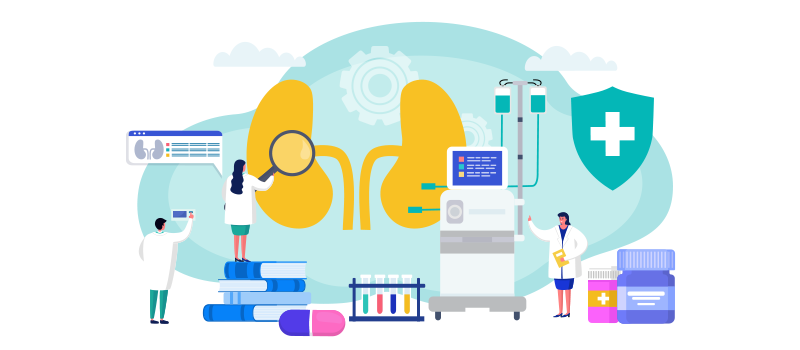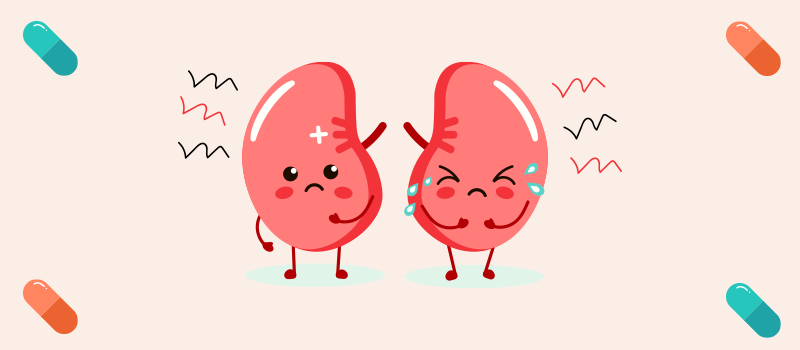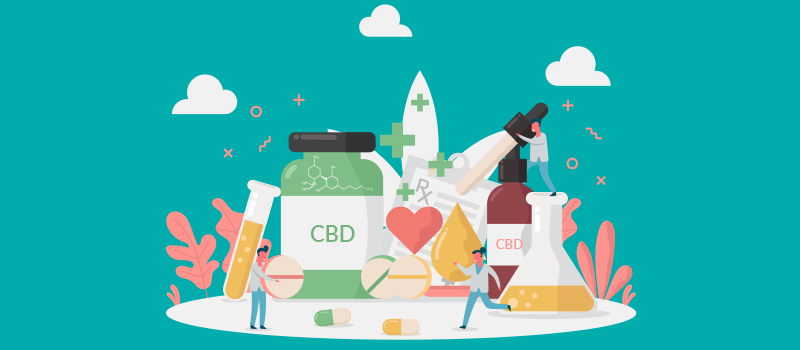What’s the Buzz
The Bee Healthy Blog
Why Are Calcium Levels Low in Renal Failure?

Calcium homeostasis is the regulation of calcium levels in the body. It is a complex process that involves four key components: serum calcium, serum phosphate, vitamin D (1,25-dihydroxyvitamin D3), and parathyroid hormone (PTH). These components regulate calcium metabolism, i.e., the movement of calcium in the gut, kidney, and bones.
Hypercalcemia is a condition in which the calcium level in the blood is above normal. Hypocalcemia is a low level of calcium in the blood. Normal levels are 8.5 to 10.2 mg/dL. High or low calcium levels outside this range indicate a disruption of calcium homeostasis. People with renal disease (advanced chronic kidney disease) may have lower serum calcium levels than normal. Please continue reading to find out why this occurs and what you can do to prevent it.
What are calcium, serum calcium, and vitamin D?
Calcium
Calcium is a mineral that is needed for many essential processes in the human body. You need calcium to build strong bones and teeth, the muscles and nerves need calcium to function properly, and the heart needs calcium to beat at a steady rate. Calcium also plays a role in blood clotting. Studies have shown that the role of calcium, along with vitamin D, extends well beyond bone health, and it may protect against high blood pressure, diabetes mellitus, and cancer.
More than 99% of the total calcium in the body is stored in the bones. But it is also found in other tissues like muscle and blood.
You need to get calcium from your diet because your body can't make this mineral. Therefore, the amount of calcium stored in your body largely depends on dietary intake, intestinal absorption, bone remodeling, and renal excretion. If you do not eat enough calcium, your body will move calcium from bones to blood to maintain serum calcium levels. If too much calcium is moved out of your bones, they can become weak, leading to a mineral and bone disorder such as osteoporosis.
Serum calcium
Serum-ionized calcium refers to the calcium in the blood. As mentioned, the body moves calcium from bone to blood and vice versa to keep serum calcium levels normal. According to the National Kidney Foundation, a normal serum calcium level is between 8.5 and 10.2 mg/dL. Serum calcium below or above this range can be dangerous and is called hypocalcemia and hypercalcemia, respectively. Both conditions need to be treated.
There is not enough calcium for the muscles, nerves, heart, and wounds in people with low serum calcium. This can cause neuromuscular, cardiovascular, and blood clotting problems.
Vitamin D
Vitamin D is a fat-soluble vitamin that, along with calcium, helps to build strong bones. The body can't make vitamin D, so you need to get it from food and by exposing your skin to sunlight.
Calcium and vitamin D work together. Calcium helps to build and maintain strong bones. Vitamin D helps your body absorb calcium effectively. If you are taking in enough calcium but deficient in vitamin D, the calcium you’re eating could be getting wasted.
What happens to calcium in renal failure?
Healthy kidneys change vitamin D obtained from food and sunlight exposure to an active form. When a person has impaired renal function or chronic renal failure, the kidneys are unable to make enough active vitamin D.
With chronic kidney disease progression, the kidneys make lesser and lesser active vitamin D, which leads to abnormal serum vitamin D levels. As a result, with kidney function decline, there is not enough active vitamin D to help absorb calcium. Therefore, vitamin D deficiency leads the body to absorb less calcium, which, in turn, leads to low serum calcium.
Also, in advanced kidney disease, the kidneys cannot filter out serum phosphorus. As a result, there is extra phosphorus in the blood of people with chronic kidney disease. This phosphorus can bind to the calcium in the blood and further lower serum calcium.
Does renal failure cause hypocalcemia or hypercalcemia?
There is a complex relationship between calcium, vitamin D, the kidneys, and the calcium-regulating gland called the parathyroid gland. In people with chronic kidney disease (CKD) and kidney failure, there is a calcium imbalance. As noted above, such individuals can have chronic renal failure induced hypocalcemia (low ionized calcium in the blood).
However, kidney failure can also lead to high serum calcium levels (hypercalcemia). This occurs due to secondary hyperparathyroidism. What happens is this: The low levels of calcium in the blood that occur in people with chronic kidney disease lead to the production of more parathyroid hormone (PTH). As mentioned, PTH is a calcium-regulating hormone. It maintains serum calcium levels by increasing calcium absorption from food and taking calcium out of the bones. Large quantities of PTH may be produced in patients with chronic kidney disease in response to the low blood calcium levels. Ultimately, the parathyroid glands can go out of control, resulting in persistently higher serum calcium levels.
Does CKD cause hypocalcemia? Why is this important?
Yes, as noted above, chronic kidney disease (CKD) can cause low serum calcium (hypocalcemia). This is important because studies have shown that patients with low serum calcium, or even calcium levels at the lower end of the normal range, reach end-stage renal disease and kidney failure faster than people with a normal serum calcium level. Therefore, low serum calcium and low vitamin D levels caused by CKD can signify that kidney function is worsening and heading toward kidney failure.
What are the signs and symptoms of low calcium?
It is important to see a healthcare provider who can evaluate early kidney disease, monitor calcium and phosphorus levels, and prevent poor renal outcomes. Some of the signs and symptoms of hypocalcemia (low serum calcium) may include paresthesias (pins and needles sensations), muscle spasms, dry skin, hair loss, low blood pressure, heart rhythm abnormalities, and seizures.
What should I do to keep my serum calcium level normal?
Impaired kidney function or chronic kidney disease is a risk factor for hypocalcemia (low serum calcium). You can lower your risk of developing low serum calcium by eating a healthy, well-balanced diet and taking calcium supplements if needed. Remember that other nutrients like vitamin D and magnesium are necessary to absorb calcium efficiently.
CKD patients should not take a calcium supplement or vitamin D supplement without talking to their healthcare team. They should work with a dietitian to develop a dietary plan that fits their needs. While dairy foods are good sources of dietary calcium, these foods may also contain high amounts of phosphorus, which needs to be limited in people with chronic kidney disease. A dietitian can help CKD patients find the right foods to meet their dietary needs. The healthcare team and/or dietician may prescribe a vitamin D supplement if needed. They may also prescribe a medicine called a phosphate binder to lower serum phosphorus levels.
References:











SOCIAL